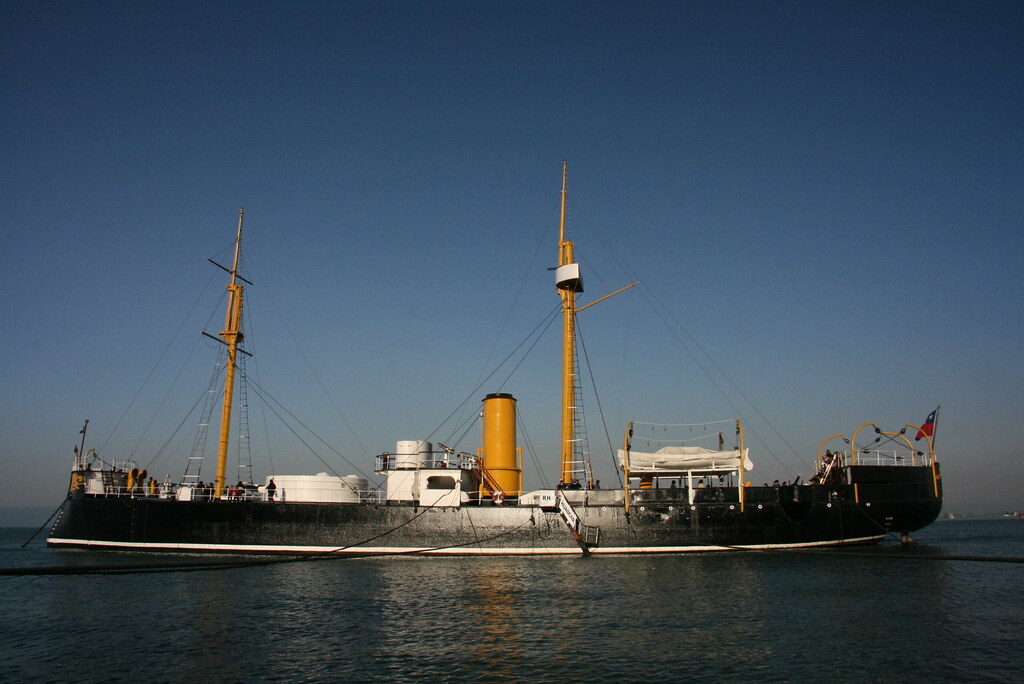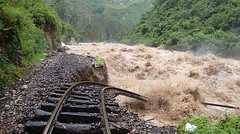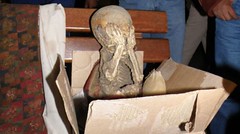Miguel Grau and the Battle of Angamos
Known as the Gentleman of the Seas, Admiral Miguel Grau is remembered by friends and enemies alike as not only a great tactician in naval warfare, but also for his chivalry, the likes of which had not been seen before or since. He died in combat defending Peru against invading aggressors at the Battle of Angamos on the 8th of October 1879, and is remembered on this day each year with a public holiday.
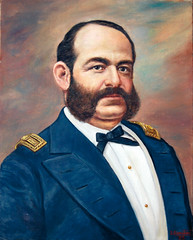
Admiral Miguel Grau
Miguel Grau was born in Paita on the 27th of July 1834, to a father with military experience fighting with Bolivar to liberate South America, and to a mother from the Pacific Ocean town of Paita who loved the sea. Enrolling in the Paita Nautical School, from just 9 years old he was sailing up and down the South American coast working on various ships, and later as far as Oceana, Asia, Europe and North America.
In 1853, at the age of 19, he left the merchant marines and became an officer candidate of the Peruvian Navy. Already with a lifetime of experience and incredibly bright, he rose through the ranks at break-neck speed. A decade later in 1864 he was sent to the UK, to the Laird shipyards in Birkenhead, Merseyside, to oversea the building and delivery of new iron-clad battleships for Peru. One of these was the Huáscar which he would later captain and die on.
On returning to Peru, he was thrust straight into battle, joining forces with Chile to defeat a Spanish force determined to reconquer its ex-colonies. His performance earned him a promotion to Frigate Captain, with which he left the navy to embark on a political career.
War with Chile: the War of the Pacific
After the discovery of nitrates in the Atacama desert, shared between Peru, Bolivia and Chile and divided with poorly defined borders, the three countries began exploiting the resource. Most of the mines were Chilean-run but admittedly on Bolivian territory for which they paid an extraction tax. This was something the Chileans were loath to do, not just for the reduction in profits, but also because of deteriorating relations with both Bolivia and Peru who had signed a number of friendship agreements.
Peru in the centuries past had been the centre of the Spanish Empire, making it extremely powerful and wealthy. It was also blessed with almost endless natural resources and was the centre of learning and trade for the entire region. Its territory once included countries like Ecuador, Bolivia and Chile. The recent agreements with Bolivia, from the Chilean point of view, was a sign of a Peruvian resurgence to past strength. Peru was beginning again to outshine Chile which after centuries of trying to make something out of their land of desert, swamp and ice were finally starting to do so. Valparaíso was now an important port, and Santiago no longer a forgotten backwater.
It was this general feeling of a “northern threat”, which took the form of a military, economic and political alliance signed between Peru and Bolivia, that eventually led to war. With almost everything the now economically thriving Chile had invested in the north, when Bolivia decided to increase taxes, Chile decided to go to war. Confident in beating Bolivia and taking control of its mineral wealth on the coast, Peru, who was obliged to aid Bolivia was their only problem.
Battles at Sea

Huáscar
Bolivia had no navy, so Peru was forced to do all the fighting on their behalf. Peru’s navy had long since been more powerful than that of Chile, which until recently only had old-fashioned wooden ships. Chile though had recently taken ownership of a couple of heavy ironclads, the Cochrane and the Blanco Encalada. Peru had four smaller but faster ironclads.
Miguel Grau, called up by his country to fight against Chile, was made captain of the ironclad Huáscar. Wisely, he took advantage of the ship’s strengths, its agility and speed, and wrecked havoc on Chile’s lines of supply and communication. His efforts protected Peru, and Bolivia, from any sea or land invasion.
The Peruvian port city of Iquique was blockaded by Chile and its ship Esmeralda. Grau rushed to the city with his superior ship. The captain of the Esmeralda, Arturo Prat, refused to surrender, and placed his ship between the Huáscar and the port so that the Huáscar’s fire would hit Iquique. The Chileans suffered heavy losses, while Prat gave a speech demanding that his sailors never surrender. With many dead, all Chileans, Grau was dismayed. He again called on Prat to surrender, but was eventually forced to sink his ship. With hundreds of Chilean sailors drowning, Grau rushed to give the order to save as many as possible. When dropped off back on dry land, the sailors cheered “long live generous Peru!”
Feeling terrible about not being able to convince Prat to surrender, he collected his belongings and sent them to Prat’s wife along with a letter;-
Dear Madam:
I have a sacred duty that authorizes me to write you, despite knowing that this letter will deepen your profound pain, by reminding you of recent battles.
During the naval combat that took place in the waters of Iquique, between the Chilean and Peruvian ships, on the 21st day of the last month, your worthy and valiant husband Captain Mr. Arturo Prat, Commander of the Esmeralda, was, like you would not ignore any longer, victim of his reckless valor in defense and glory of his country’s flag.
While sincerely deploring this unfortunate event and sharing your sorrow, I comply with the sad duty of sending you some of his belongings, invaluable for you, which I list at the end of this letter. Undoubtedly, they will serve of small consolation in the middle of your misfortune, and I have hurried in remitting them to you.
Reiterating my feelings of condolence, I take the opportunity of offering you my services, considerations and respects and I render myself at your disposal.
Battle of Angamos
Known now as the Gentleman of the Seas, and after the loss of other Peruvian ships, Miguel Grau continued on, fighting Chile single-handedly.
Since Chile’s plan was to achieve naval supremacy prior to invading Bolivian and Peruvian territory, because of the logistic advantage needed to launch a terrestrial campaign, no attempt to disembark troops could be made. The Huáscar was preventing the Chilean Navy from taking control of the sea. In order to finish the naval stage, the Huáscar had to be eliminated or captured. They sent their entire navy north to meet Grau.
Chile now had two ironclads and three corvettes against Grau’s one ironclad. The Chileans devised a plan to trap the Huáscar and prevent it from sailing north to Peru once Grau realised the force he was up against. Then plan worked and Grau’s ship was trapped at Punta Angamos. Heavy fire severely damaged the ship. This time the Huáscar was out matched. One particularly damaging shot took out the crew of the 300lb guns and left the ship adrift, while another pierced the bridge and killed the Gentleman and the Seas instantly. Command fell to Lt Captain Elias Aguirre who did the best he could against the inevitable.
After considering surrender, the crew of the Huáscar managed to quickly repair much of the ship, and on they bravely went.
But now firing at point blank range, the Chilean ships Blanco Encalada and Covadonga, continued to inflict heavy damage. The emergency repairs on the rudder were destroyed and the Huáscar now sailed out of control. Another shot killed Aguirre and all in control of the ship. Command then fell to a lieutenant who with the remains of the crew decided to sink the ship rather than face slaughter at the hands of the enemy and let the ship fall into their hands.
But it was too late. Chilean marines boarded the Huáscar and captured it. Peruvian Naval defence was now crippled, and the Chileans were free to land troops where they pleased on the Pacific Coast. They took from Bolivia the entirety of its coastline and mineral resources leaving it in dire economic difficulties that continue to this day. In Peru, the Chileans captured town after town, burning many to the ground before reaching Lima, where only thanks to foreign pressure to preserve the port of Callao for its economic importance did they not destroy the city. Peru lost is southern territory and Chile grew rich, and to this day, it’s economy is based on exports from the region.
Admiral
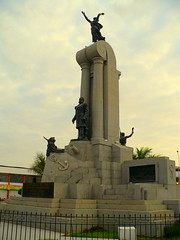
Monument in the city of Piura
Peruvians mourned the loss of not only a military hero, but also a man who went above and beyond to preserve life, even under enemy fire. Even in Chile he is paid great respect. In the Huáscar, turned into a museum by Chile, his portrait hangs and his deeds are recounted.
In 1967 Grau was posthumously awarded the rank of Grand Admiral of Peru, and throughout the last century statues with his likeness have sprung up across the country, and many streets bare his name.
The 8th of October is now a national holiday in Peru, a day set aside to remember Admiral Miguel Grau, the Gentleman of the Seas.
Tags: admiral miguel grau, angamos, antofagasta, bolivia, british, chile, huascar, iquique, mining, navy, nitrates, paita, piura, war of the pacific


